weight INFINITI QX56 2011 Factory Owner's Manual
[x] Cancel search | Manufacturer: INFINITI, Model Year: 2011, Model line: QX56, Model: INFINITI QX56 2011Pages: 5598, PDF Size: 94.53 MB
Page 2540 of 5598
![INFINITI QX56 2011 Factory Owners Manual
EC-516
< DTC/CIRCUIT DIAGNOSIS >[VK56VD]
ON BOARD REFUELING VAPOR RECOVERY (ORVR)
ON BOARD REFUELING VA
POR RECOVERY (ORVR)
Component Function CheckINFOID:0000000006256490
1.CHECK ORVR FUNCTION
Check INFINITI QX56 2011 Factory Owners Manual
EC-516
< DTC/CIRCUIT DIAGNOSIS >[VK56VD]
ON BOARD REFUELING VAPOR RECOVERY (ORVR)
ON BOARD REFUELING VA
POR RECOVERY (ORVR)
Component Function CheckINFOID:0000000006256490
1.CHECK ORVR FUNCTION
Check](/img/42/57033/w960_57033-2539.png)
EC-516
< DTC/CIRCUIT DIAGNOSIS >[VK56VD]
ON BOARD REFUELING VAPOR RECOVERY (ORVR)
ON BOARD REFUELING VA
POR RECOVERY (ORVR)
Component Function CheckINFOID:0000000006256490
1.CHECK ORVR FUNCTION
Check whether the following symptoms are present.
Fuel odor from EVAP canister is strong.
Cannot refuel/Fuel odor from the fuel filler opening is strong while refueling.
Are any symptoms present?
YES >> Proceed to EC-516, "Diagnosis Procedure".
NO >> INSPECTION END
Diagnosis ProcedureINFOID:0000000006256491
1.INSPECTION START
Check whether the following symptoms are present.
A: Fuel odor from EVAP canister is strong.
B: Cannot refuel/Fuel odor from the fuel filler opening is strong while refueling.
Which symptom is present?
A>>GO TO 2.
B>>GO TO 7.
2.CHECK EVAP CANISTER
1. Remove EVAP canister with EVAP canister vent control valve and EVAP control system pressure sensor
attached.
2. Weigh the EVAP canister with EVAP canister vent control valve and EVAP control system pressure sensor
attached.
The weight should be l ess than 2.5 kg (5.5 lb).
Is the inspection result normal?
YES >> GO TO 3.
NO >> GO TO 4.
3.CHECK IF EVAP CANISTER IS SATURATED WITH WATER
Check if water will drain from EVAP canister (1).
EVAP canister vent control valve (2)
Does water drain from the EVAP canister?
YES >> GO TO 4.
NO >> GO TO 6.
4.REPLACE EVAP CANISTER
Replace EVAP canister with a new one.
>> GO TO 5.
5.DETECT MALFUNCTIONING PART
Check the EVAP hose between EVAP canister and vehicle frame for clogging or poor connection.
>> Repair or replace EVAP hose.
6.CHECK REFUELING EVAP VAPOR CUT VALVE
Refer to EC-518, "
Component Inspection (EVAP Vapor Cut Valve)".
JSBIA0692ZZ
Revision: 2010 May2011 QX56
Page 2541 of 5598
![INFINITI QX56 2011 Factory Owners Manual
ON BOARD REFUELING VAPOR RECOVERY (ORVR)EC-517
< DTC/CIRCUIT DIAGNOSIS > [VK56VD]
C
D
E
F
G H
I
J
K L
M A
EC
NP
O
Is the inspection result normal?
YES >> INSPECTION END
NO >> Replace refueling EVAP v INFINITI QX56 2011 Factory Owners Manual
ON BOARD REFUELING VAPOR RECOVERY (ORVR)EC-517
< DTC/CIRCUIT DIAGNOSIS > [VK56VD]
C
D
E
F
G H
I
J
K L
M A
EC
NP
O
Is the inspection result normal?
YES >> INSPECTION END
NO >> Replace refueling EVAP v](/img/42/57033/w960_57033-2540.png)
ON BOARD REFUELING VAPOR RECOVERY (ORVR)EC-517
< DTC/CIRCUIT DIAGNOSIS > [VK56VD]
C
D
E
F
G H
I
J
K L
M A
EC
NP
O
Is the inspection result normal?
YES >> INSPECTION END
NO >> Replace refueling EVAP vapor cut valve with fuel tank.
7.CHECK EVAP CANISTER
1. Remove EVAP canister with EVAP canister vent c ontrol valve and EVAP control system pressure sensor
attached.
2. Weigh the EVAP canister with EVAP canister vent control valve and EVAP control system pressure sensor
attached.
The weight should be l ess than 2.5 kg (5.5 lb).
Is the inspection result normal?
YES >> GO TO 8.
NO >> GO TO 9.
8.CHECK IF EVAP CANISTER IS SATURATED WITH WATER
Check if water will drain from EVAP canister (1).
EVAP canister vent control valve (2)
Does water drain from the EVAP canister?
YES >> GO TO 9.
NO >> GO TO 11.
9.REPLACE EVAP CANISTER
Replace EVAP canister with a new one.
>> GO TO 10.
10.DETECT MALFUNCTIONING PART
Check the EVAP hose between EVAP canister and vehicle frame for clogging or poor connection.
>> Repair or replace EVAP hose.
11 .CHECK VENT HOSES AND VENT TUBES
Check hoses and tubes between EVAP c anister and refueling control valve for clogging, kinks, looseness and
improper connection.
Is the inspection result normal?
YES >> GO TO 12.
NO >> Repair or replace hoses and tubes.
12.CHECK FILLER NECK TUBE
Check recirculation line for clogging, dents and cracks.
Is the inspection result normal?
YES >> GO TO 13.
NO >> Replace filler neck tube.
13.CHECK REFUELING EVAP VAPOR CUT VALVE
Refer to EC-518, "
Component Inspection (EVAP Vapor Cut Valve)".
Is the inspection result normal?
YES >> GO TO 14.
NO >> Replace refueling EVAP vapor cut valve with fuel tank.
14.CHECK FUEL FILLER TUBE
Check filler neck tube and hose connected to the fuel tank for clogging, dents and cracks.
JSBIA0692ZZ
Revision: 2010 May2011 QX56
Page 2550 of 5598
![INFINITI QX56 2011 Factory Owners Manual
EC-526
< SYMPTOM DIAGNOSIS >[VK56VD]
ENGINE CONTROL SYSTEM SYMPTOMS
1 - 6: The numbers refer to the order of inspection.
(continued on next page)
SYSTEM — ENGINE MECHANICAL & OTHER
Manifold absolut INFINITI QX56 2011 Factory Owners Manual
EC-526
< SYMPTOM DIAGNOSIS >[VK56VD]
ENGINE CONTROL SYSTEM SYMPTOMS
1 - 6: The numbers refer to the order of inspection.
(continued on next page)
SYSTEM — ENGINE MECHANICAL & OTHER
Manifold absolut](/img/42/57033/w960_57033-2549.png)
EC-526
< SYMPTOM DIAGNOSIS >[VK56VD]
ENGINE CONTROL SYSTEM SYMPTOMS
1 - 6: The numbers refer to the order of inspection.
(continued on next page)
SYSTEM — ENGINE MECHANICAL & OTHER
Manifold absolute pressure sensor circuit 3
EC-210
Battery current sensor 4 5 5 3EC-412EC-420
EC-424
Heated oxygen sensor 2 6 6 6 6 5EC-243EC-249
EC-257
SYMPTOM
Reference
page
HARD/NO START/RESTART (EXCP. HA)
ENGINE STALL
HESITATION/SURGING/FLAT SPOT
SPARK KNOCK/DETONATION
LACK OF POWER/POOR ACCELERATION
HIGH IDLE/LOW IDLE
ROUGH IDLE/HUNTING
IDLING VIBRATION
SLOW/NO RETURN TO IDLE
OVERHEATS/WATER TEMPERATURE HIGH
EXCESSIVE FUEL CONSUMPTION
EXCESSIVE OIL CONSUMPTION
BATTERY DEAD (UNDER CHARGE)
Warranty symptom code AA AB AC AD AE AF AG AH AJ AK AL AM HA
SYMPTOM
Reference
page
HARD/NO START/RESTART (EXCP. HA)
ENGINE STALL
HESITATION/SURGING/FLAT SPOT
SPARK KNOCK/DETONATION
LACK OF POWER/POOR ACCELERATION
HIGH IDLE/LOW IDLE
ROUGH IDLE/HUNTING
IDLING VIBRATION
SLOW/NO RETURN TO IDLE
OVERHEATS/WATER TEMPERATURE HIGH
EXCESSIVE FUEL CONSUMPTION
EXCESSIVE OIL CONSUMPTION
BATTERY DEAD (UNDER CHARGE)
Warranty symptom code AA AB AC AD AE AF AG AH AJ AK AL AM HA
Fuel Fuel tank 5
5 FL-4
Fuel piping 555 55 5
FL-4
Vapor lock —
Valve deposit 5 555 55 5 —
Poor fuel (Heavy weight gasoline,
Low octane) —
Revision: 2010 May2011 QX56
Page 2665 of 5598
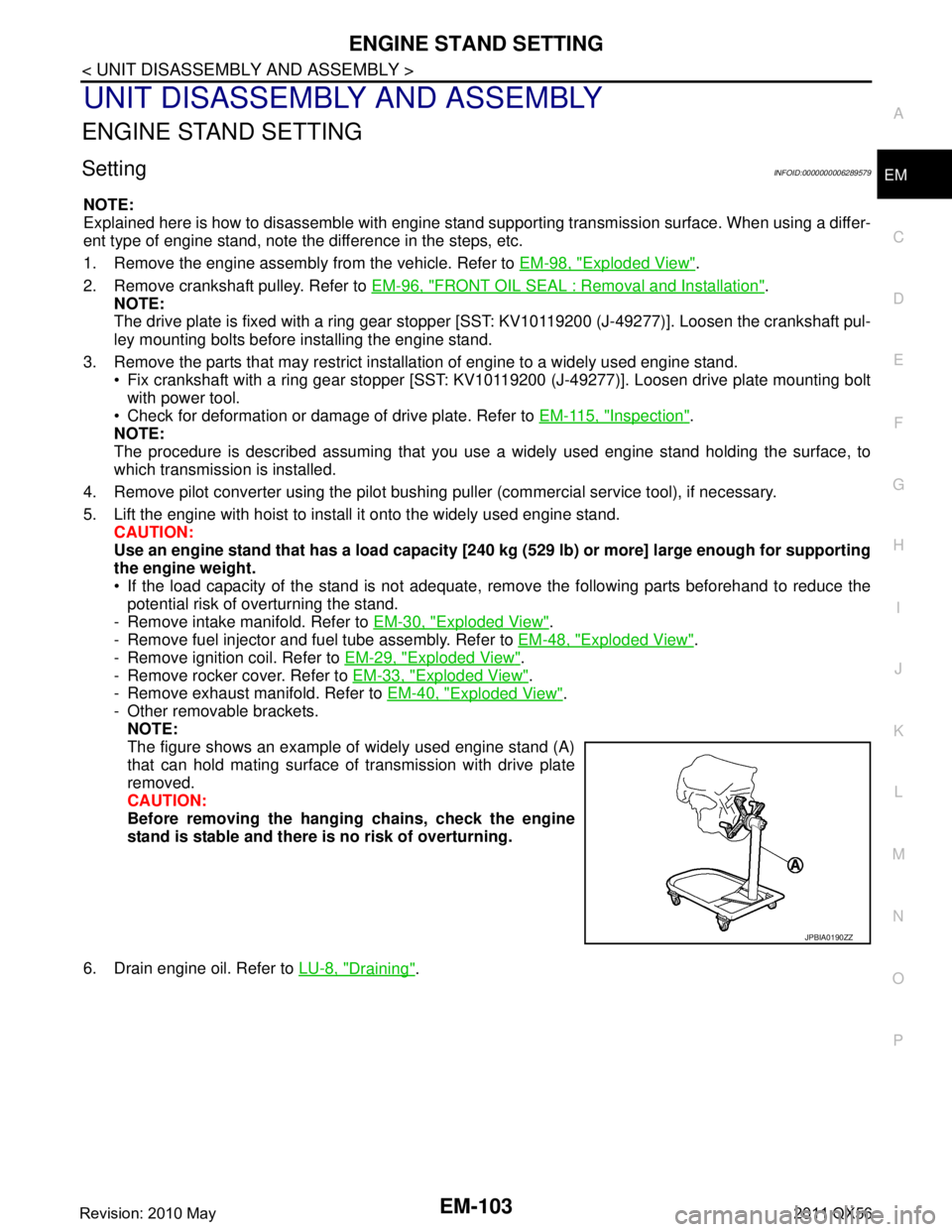
ENGINE STAND SETTINGEM-103
< UNIT DISASSEMBLY AND ASSEMBLY >
C
DE
F
G H
I
J
K L
M A
EM
NP
O
UNIT DISASSEMBLY AND ASSEMBLY
ENGINE STAND SETTING
SettingINFOID:0000000006289579
NOTE:
Explained here is how to disassemble with engine stand s
upporting transmission surface. When using a differ-
ent type of engine stand, note the difference in the steps, etc.
1. Remove the engine assembly from the vehicle. Refer to EM-98, "
Exploded View".
2. Remove crankshaft pulley. Refer to EM-96, "
FRONT OIL SEAL : Removal and Installation".
NOTE:
The drive plate is fixed with a ring gear stopper [SST: KV10119200 (J-49277)]. Loosen the crankshaft pul-
ley mounting bolts before installing the engine stand.
3. Remove the parts that may restrict installation of engine to a widely used engine stand. Fix crankshaft with a ring gear stopper [SST: KV10119200 (J-49277)]. Loosen drive plate mounting bolt
with power tool.
Check for deformation or damage of drive plate. Refer to EM-115, "
Inspection".
NOTE:
The procedure is described assuming that you us e a widely used engine stand holding the surface, to
which transmission is installed.
4. Remove pilot converter using the pilot bushing puller (commercial service tool), if necessary.
5. Lift the engine with hoist to inst all it onto the widely used engine stand.
CAUTION:
Use an engine stand that has a load capacity [240 kg (529 lb) or more] large enough for supporting
the engine weight.
If the load capacity of the stand is not adequate, remove the following parts beforehand to reduce the potential risk of overturning the stand.
- Remove intake manifold. Refer to EM-30, "
Exploded View".
- Remove fuel injector and fuel tube assembly. Refer to EM-48, "
Exploded View".
- Remove ignition coil. Refer to EM-29, "
Exploded View".
- Remove rocker cover. Refer to EM-33, "
Exploded View".
- Remove exhaust manifold. Refer to EM-40, "
Exploded View".
- Other removable brackets. NOTE:
The figure shows an example of widely used engine stand (A)
that can hold mating surface of transmission with drive plate
removed.
CAUTION:
Before removing the hang ing chains, check the engine
stand is stable and there is no risk of overturning.
6. Drain engine oil. Refer to LU-8, "
Draining".
JPBIA0190ZZ
Revision: 2010 May2011 QX56
Page 2670 of 5598
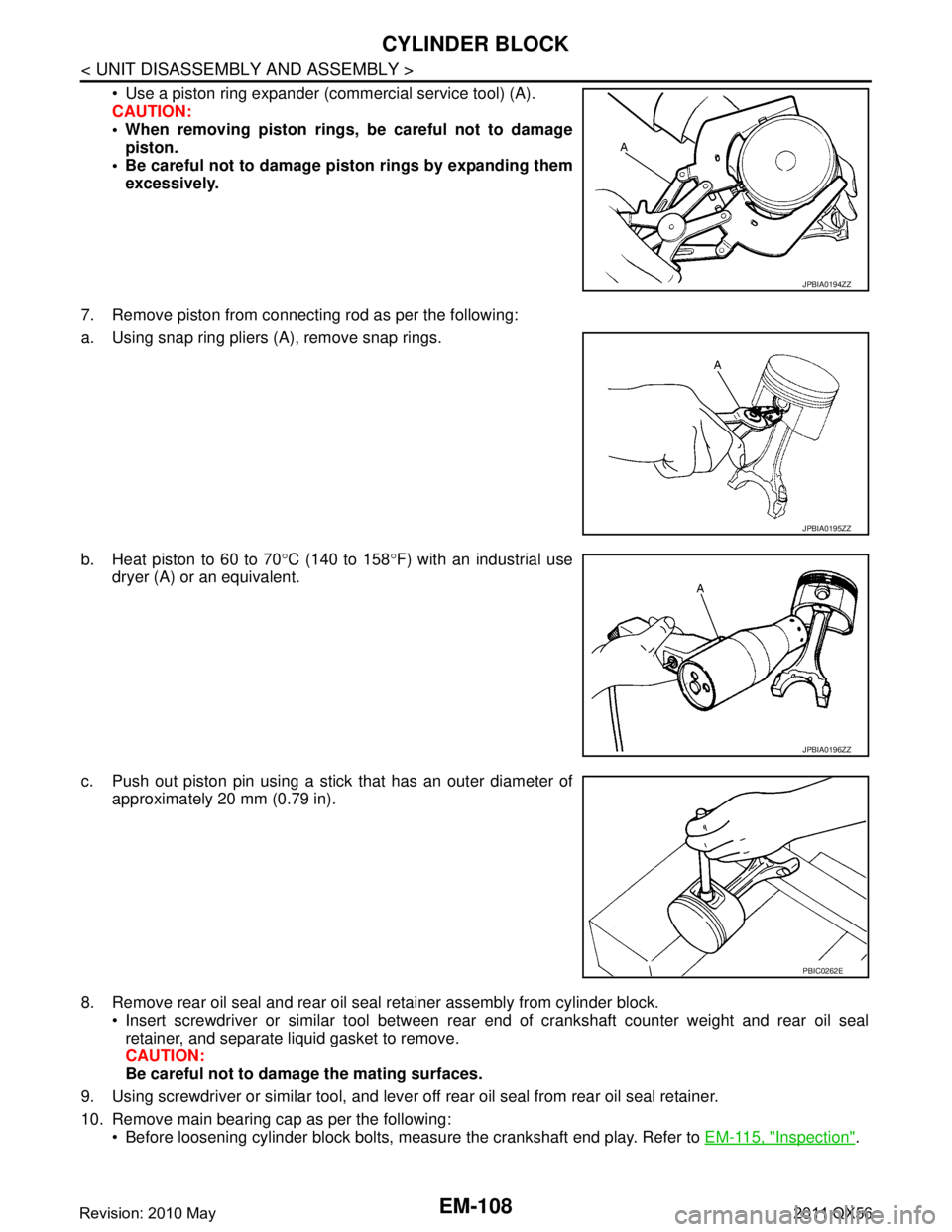
EM-108
< UNIT DISASSEMBLY AND ASSEMBLY >
CYLINDER BLOCK
Use a piston ring expander (commercial service tool) (A).
CAUTION:
When removing piston rings, be careful not to damagepiston.
Be careful not to damage piston rings by expanding them
excessively.
7. Remove piston from connecting rod as per the following:
a. Using snap ring pliers (A), remove snap rings.
b. Heat piston to 60 to 70 °C (140 to 158 °F) with an industrial use
dryer (A) or an equivalent.
c. Push out piston pin using a stick that has an outer diameter of approximately 20 mm (0.79 in).
8. Remove rear oil seal and rear oil seal retainer assembly from cylinder block. Insert screwdriver or similar tool between rear end of crankshaft counter weight and rear oil sealretainer, and separate liquid gasket to remove.
CAUTION:
Be careful not to damage the mating surfaces.
9. Using screwdriver or similar tool, and lever off rear oil seal from rear oil seal retainer.
10. Remove main bearing cap as per the following: Before loosening cylinder block bolts, measure the crankshaft end play. Refer to EM-115, "
Inspection".
JPBIA0194ZZ
JPBIA0195ZZ
JPBIA0196ZZ
PBIC0262E
Revision: 2010 May2011 QX56
Page 2676 of 5598

EM-114
< UNIT DISASSEMBLY AND ASSEMBLY >
CYLINDER BLOCK
Before installing connecting rod bearings, apply engine oil to the bearing surface (inside). Do not applyengine oil to the back surface, but thoroughly clean it.
When installing, align connecting rod bearing stopper protru-
sion (B) with cutout (A) of connecting rods and connecting rod
bearing caps to install.
Ensure the oil hole (C) on connecting rod and that on the cor-
responding bearing are aligned.
13. Install piston and connecting rod assembly to crankshaft. Position crankshaft pin corresponding to connecting rod to be installed onto the bottom dead center.
Apply engine oil sufficiently to the cylinder bore, piston and crankshaft pin journal.
Match the cylinder position with the cyli nder number on connecting rod to install.
Be sure that front mark on piston cr own is facing the front of the engine.
Using a piston ring compressor [SST: EM03470000 (J-8037)]
(A) or suitable tool, install piston with the front mark on the pis-
ton crown facing the front of the engine.
CAUTION:
Be careful not to damage the cylinder wall and crankshaft
pin, resulting from an interf erence of the connecting rod big
end.
14. Install connecting rod bearing cap. Match the stamped cylinder number marks on connecting rodwith those on connecting rod bearing cap to install.
Be sure that front mark (H) on connecting rod bearing cap is facing the front of the engine.
15. Tighten connecting rod bolts as per the following:
a. Inspect the outer diameter of connecting rod bolt. Refer to EM-115, "
Inspection".
b. Apply engine oil to the threads and seats of connecting rod bolts.
c. Tighten connecting rod bolts.
d. Completely loosen connecting rod bolts.
e. Tighten connecting rod bolts.
JPBIA2272ZZ
PBIC3244J
A: Sample codes
B : Bearing stopper groove
C : Small-end diameter grade
D : Big-end diameter grade
E : Weight grade
F : Cylinder No.
G : Management code
: 29.4 N·m (3.0 kg-m, 21.7 ft-lb)
: 0 N·m (0 kg-m, 0 ft-lb)
JPBIA2273ZZ
Revision: 2010 May2011 QX56
Page 2688 of 5598
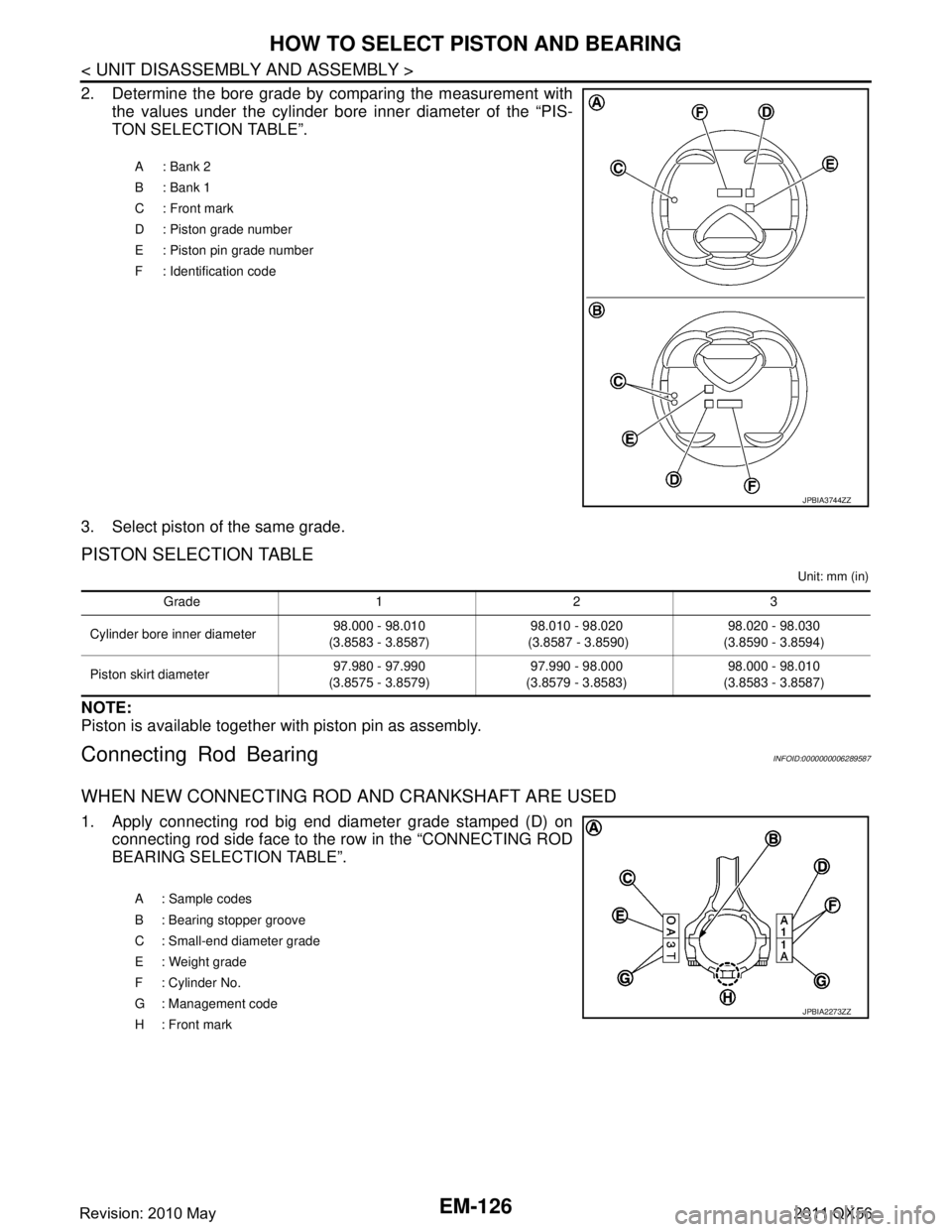
EM-126
< UNIT DISASSEMBLY AND ASSEMBLY >
HOW TO SELECT PISTON AND BEARING
2. Determine the bore grade by comparing the measurement withthe values under the cylinder bore inner diameter of the “PIS-
TON SELECTION TABLE”.
3. Select piston of the same grade.
PISTON SELECTION TABLE
Unit: mm (in)
NOTE:
Piston is available together with piston pin as assembly.
Connecting Rod BearingINFOID:0000000006289587
WHEN NEW CONNECTING ROD AND CRANKSHAFT ARE USED
1. Apply connecting rod big end diameter grade stamped (D) on connecting rod side face to the row in the “CONNECTING ROD
BEARING SELECTION TABLE”.
A: Bank 2
B: Bank 1
C : Front mark
D : Piston grade number
E : Piston pin grade number
F : Identification code
JPBIA3744ZZ
Grade 1 2 3
Cylinder bore inner diameter 98.000 - 98.010
(3.8583 - 3.8587) 98.010 - 98.020
(3.8587 - 3.8590) 98.020 - 98.030
(3.8590 - 3.8594)
Piston skirt diameter 97.980 - 97.990
(3.8575 - 3.8579) 97.990 - 98.000
(3.8579 - 3.8583) 98.000 - 98.010
(3.8583 - 3.8587)
A : Sample codes
B : Bearing stopper groove
C : Small-end diameter grade
E : Weight grade
F : Cylinder No.
G : Management code
H: Front mark
JPBIA2273ZZ
Revision: 2010 May2011 QX56
Page 2992 of 5598
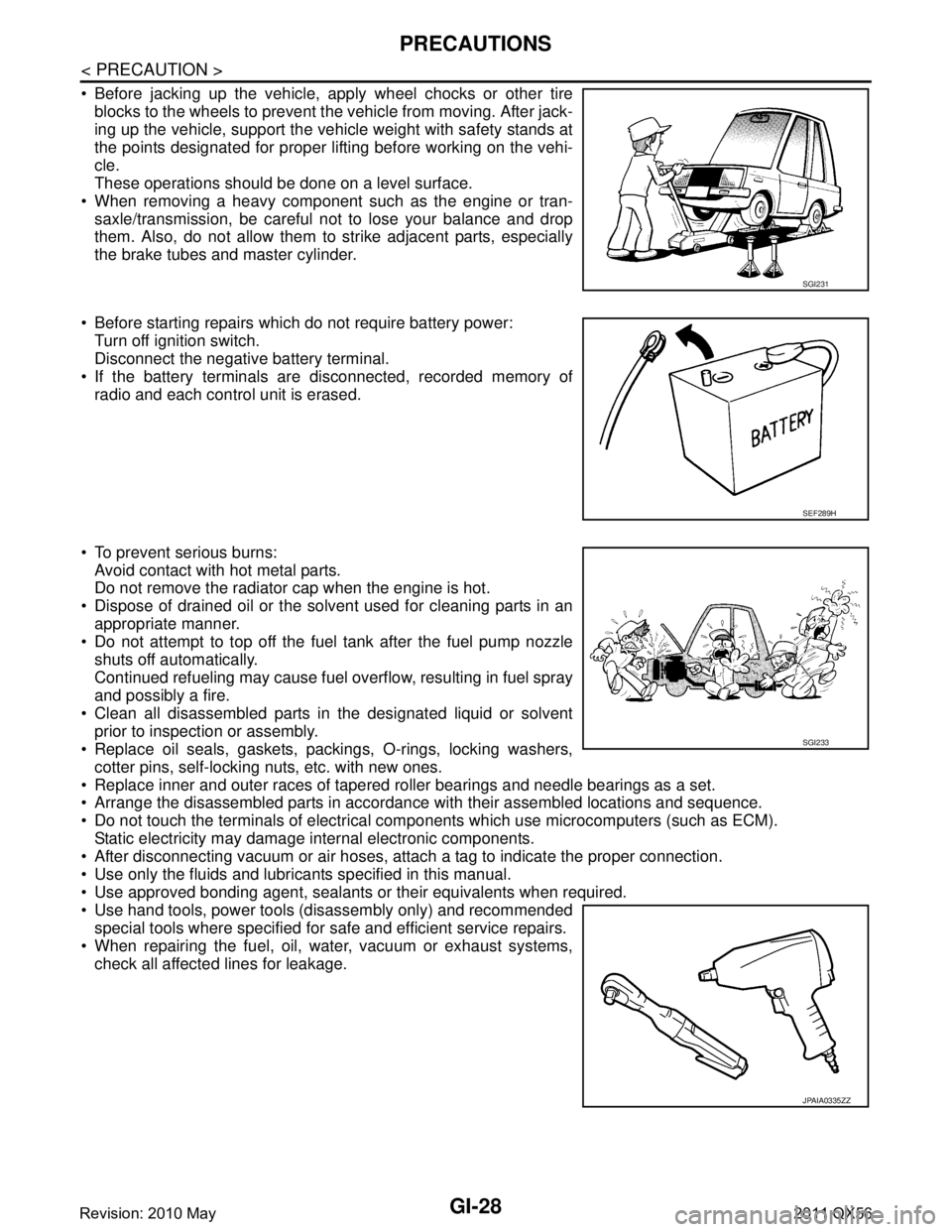
GI-28
< PRECAUTION >
PRECAUTIONS
Before jacking up the vehicle, apply wheel chocks or other tireblocks to the wheels to prevent t he vehicle from moving. After jack-
ing up the vehicle, support the vehicle weight with safety stands at
the points designated for proper lifting before working on the vehi-
cle.
These operations should be done on a level surface.
When removing a heavy component such as the engine or tran- saxle/transmission, be careful not to lose your balance and drop
them. Also, do not allow them to strike adjacent parts, especially
the brake tubes and master cylinder.
Before starting repairs which do not require battery power: Turn off ignition switch.
Disconnect the negative battery terminal.
If the battery terminals are disconnected, recorded memory of
radio and each control unit is erased.
To prevent serious burns: Avoid contact with hot metal parts.
Do not remove the radiator cap when the engine is hot.
Dispose of drained oil or the solvent used for cleaning parts in an appropriate manner.
Do not attempt to top off the fuel tank after the fuel pump nozzle
shuts off automatically.
Continued refueling may cause fuel overflow, resulting in fuel spray
and possibly a fire.
Clean all disassembled parts in the designated liquid or solvent prior to inspection or assembly.
Replace oil seals, gaskets, packings, O-rings, locking washers,
cotter pins, self-locking nuts, etc. with new ones.
Replace inner and outer races of tapered roller bearings and needle bearings as a set.
Arrange the disassembled parts in accordance with their assembled locations and sequence.
Do not touch the terminals of electrical com ponents which use microcomputers (such as ECM).
Static electricity may damage internal electronic components.
After disconnecting vacuum or air hoses, atta ch a tag to indicate the proper connection.
Use only the fluids and lubricants specified in this manual.
Use approved bonding agent, sealants or their equivalents when required.
Use hand tools, power tools (disassembly only) and recommended special tools where specified for safe and efficient service repairs.
When repairing the fuel, oil, water, vacuum or exhaust systems, check all affected lines for leakage.
SGI231
SEF289H
SGI233
JPAIA0335ZZ
Revision: 2010 May2011 QX56
Page 3064 of 5598
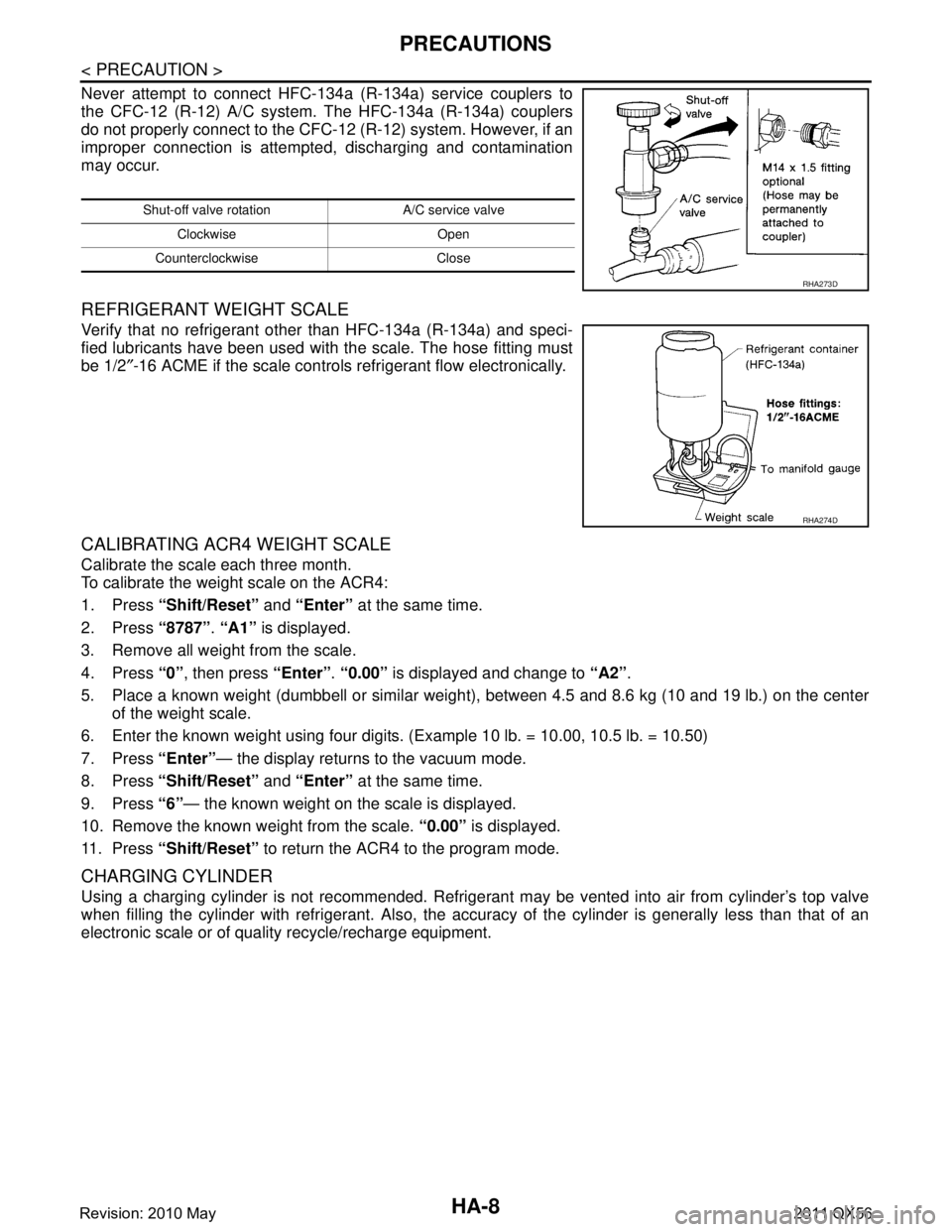
HA-8
< PRECAUTION >
PRECAUTIONS
Never attempt to connect HFC-134a (R-134a) service couplers to
the CFC-12 (R-12) A/C system. The HFC-134a (R-134a) couplers
do not properly connect to the CFC-12 (R-12) system. However, if an
improper connection is attempted, discharging and contamination
may occur.
REFRIGERANT WEIGHT SCALE
Verify that no refrigerant other than HFC-134a (R-134a) and speci-
fied lubricants have been used with the scale. The hose fitting must
be 1/2″-16 ACME if the scale controls refrigerant flow electronically.
CALIBRATING ACR4 WEIGHT SCALE
Calibrate the scale each three month.
To calibrate the weight scale on the ACR4:
1. Press “Shift/Reset” and “Enter” at the same time.
2. Press “8787”. “A1” is displayed.
3. Remove all weight from the scale.
4. Press “0”, then press “Enter”. “0.00” is displayed and change to “A2”.
5. Place a known weight (dumbbell or similar weight ), between 4.5 and 8.6 kg (10 and 19 lb.) on the center
of the weight scale.
6. Enter the known weight using four digi ts. (Example 10 lb. = 10.00, 10.5 lb. = 10.50)
7. Press “Enter”— the display returns to the vacuum mode.
8. Press “Shift/Reset” and “Enter” at the same time.
9. Press “6”— the known weight on the scale is displayed.
10. Remove the known weight from the scale. “0.00” is displayed.
11. Press “Shift/Reset” to return the ACR4 to the program mode.
CHARGING CYLINDER
Using a charging cylinder is not recommended. Refrigerant may be vented into air from cylinder’s top valve
when filling the cylinder with refrigerant. Also, the accu racy of the cylinder is generally less than that of an
electronic scale or of quality recycle/recharge equipment.
Shut-off valve rotati on A/C service valve
Clockwise Open
Counterclockwise Close
RHA273D
RHA274D
Revision: 2010 May2011 QX56
Page 3067 of 5598
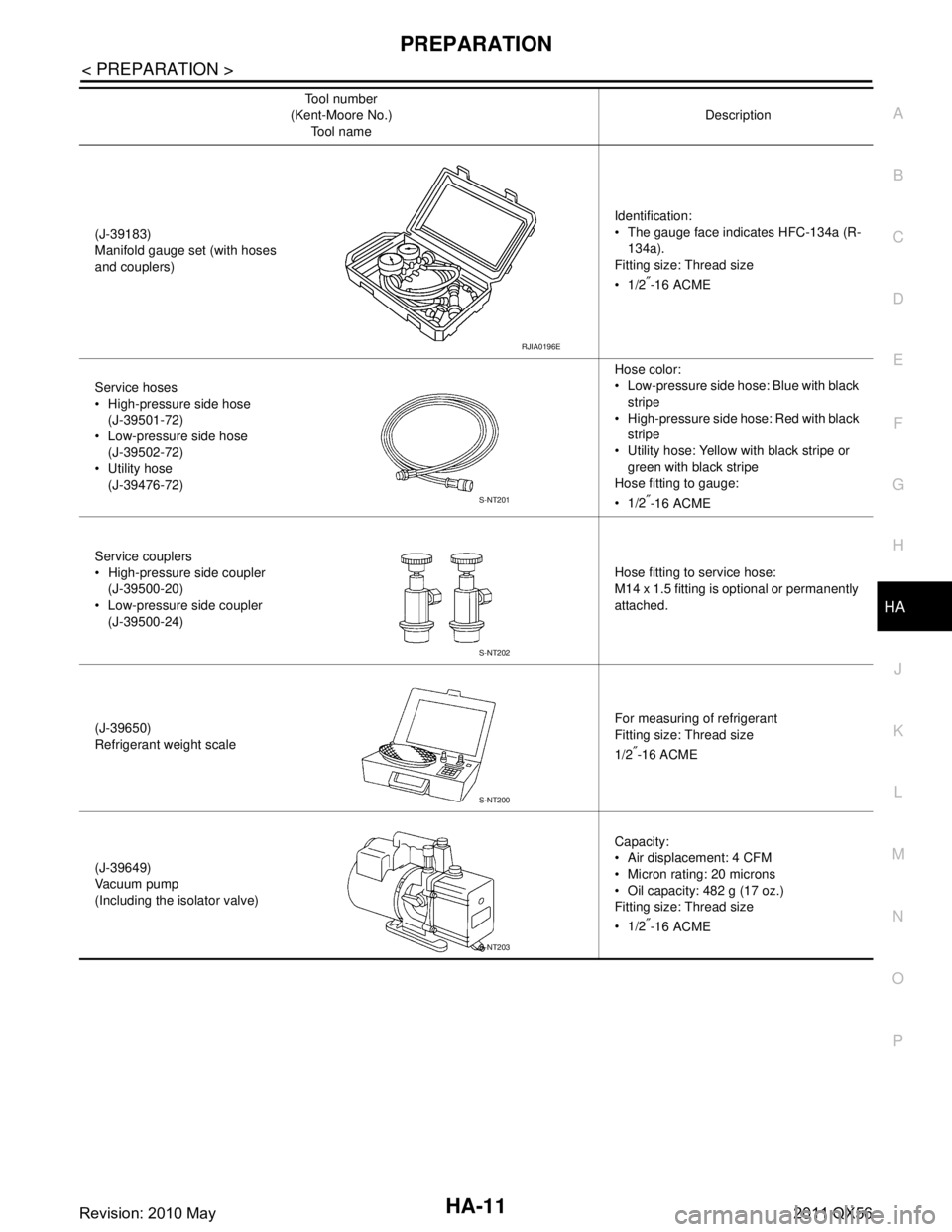
PREPARATIONHA-11
< PREPARATION >
C
DE
F
G H
J
K L
M A
B
HA
N
O P
(J-39183)
Manifold gauge set (with hoses
and couplers) Identification:
The gauge face indicates HFC-134a (R-
134a).
Fitting size: Thread size
1/2
″-16 ACME
Service hoses
High-pressure side hose (J-39501-72)
Low-pressure side hose
(J-39502-72)
Utility hose (J-39476-72) Hose color:
Low-pressure side hose: Blue with black
stripe
High-pressure side hose: Red with black stripe
Utility hose: Yellow with black stripe or
green with black stripe
Hose fitting to gauge:
1/2
″-16 ACME
Service couplers
High-pressure side coupler (J-39500-20)
Low-pressure side coupler (J-39500-24) Hose fitting to service hose:
M14 x 1.5 fitting is optional or permanently
attached.
(J-39650)
Refrigerant weight scale For measuring of refrigerant
Fitting size: Thread size
1/2
″-16 ACME
(J-39649)
Va c u u m p u m p
(Including the isolator valve) Capacity:
Air displacement: 4 CFM
Micron rating: 20 microns
Oil capacity: 482 g (17 oz.)
Fitting size: Thread size
1/2
″-16 ACME
Tool number
(Kent-Moore No.)
Tool name Description
RJIA0196E
S-NT201
S-NT202
S-NT200
S-NT203
Revision: 2010 May2011 QX56